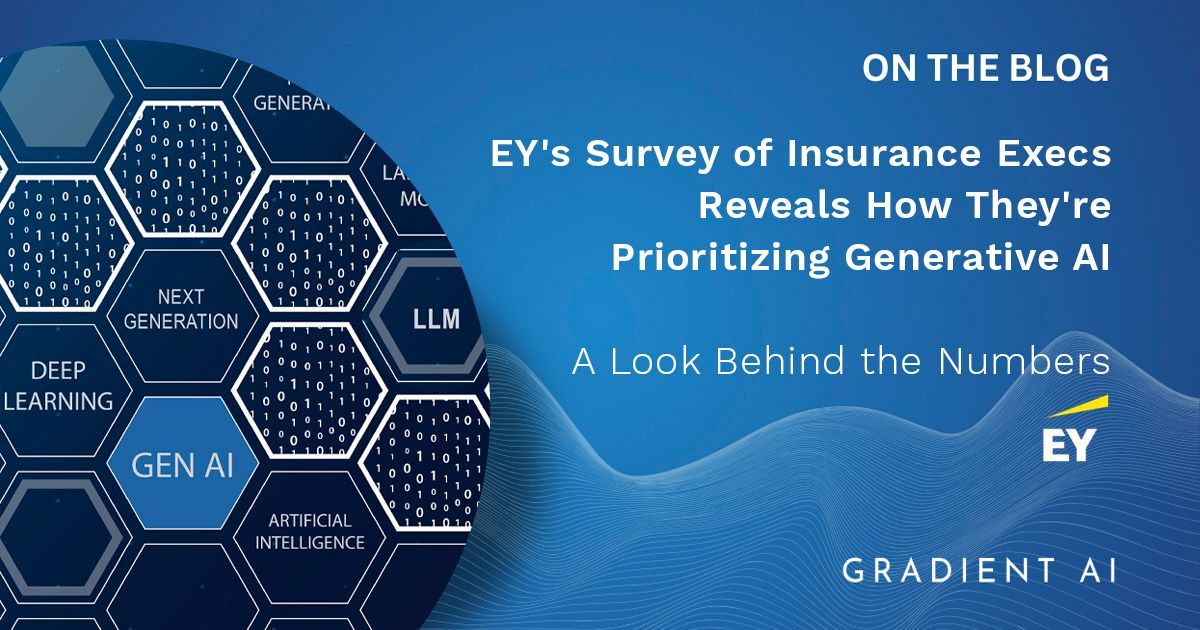EY's Survey of Insurance Execs Reveals How They're Prioritizing Generative AI: A Look Behind the Numbers
A recent EY study involving 200 senior insurance decision-makers highlights priorities and plans for generative AI in P&C and group health insurance. The study reveals global industry leaders' perspectives on the opportunities and challenges associated with GenAI and how they plan to integrate it in their organizations.
EY authors Isabelle Santenac, Gaston Messineo, and Peter Manchester wrote about the study’s results in an extensive article which you can read here.
We’ve summarized their key findings below.
The authors start off by explaining the difference between “AI” and “Generative AI” this way:
“AI is a broad term for technologies that simulate human intelligence, while GenAI is a subset of AI capable of generating new and original content such as text, images, and video. GenAI in insurance tends to be focused on enhanced underwriting, predictive risk assessment, and personalized product recommendations.”
Key Insights from the EY Study of GenAI in Insurance
1. Insurers view GenAI as an enhancement in an increasingly challenging market:
Survey respondents said they are facing proliferating risks such as climate change, natural catastrophes, cybersecurity threats, rising customer expectations for personalized experiences, and profitability pressures. They see GenAI as a transformative tool to:
- Unleash competitive disruption
- Create new revenue opportunities
- Promote operational excellence
2. The majority of insurers are rapidly adopting GenAI:
42% of insurers said they are already investing in, and 57% said they are planning to invest in GenAI in the next few years. In terms of the use cases they are prioritizing, respondents said this:
- 69% of all insurers are focusing on transforming specific parts of the value chain, like underwriting, for quick wins
- 54% of P&C insurers are prioritizing predictive risk assessments
- 62% of group health providers are focusing on decision support tools
3. GenAI is adding tangible value for insurers: survey respondents are expecting to reap positive benefits by implementing GenAI. They cited these specific benefits:
- 82% of large insurers cite productivity gains as a primary driver in adopting GenAI
- 65% of all insurers expect a revenue uplift of more than 10%
- 52% of respondents anticipate cost savings of 11-20%
4. Insurers consider GenAI adoption a strategic priority:
Some insurers are moving ahead with initial applications, while others are focusing on robust governance models and delivery capabilities before wide-scale deployment. Many respondents said they have dedicated implementation teams with direct links to the C-suite and board. The EY survey results emphasize the value of a
two-track approach to implementing generative AI:
1. Encourage bottom-up experimentation by:
- Equipping teams with GenAI tools and sandbox environments
- Promoting a culture of innovation and quick-win use cases
2. Develop enterprise strategic and technical Infrastructure by:
- Crafting a long-term GenAI vision
- Mobilizing cross-functional teams and centralize management
- Establishing strong data governance practices
- Defining measurable business outcomes and KPIs
Conclusion: Generative AI Adoption Trends in Insurance
An overwhelming number of respondents see the benefits of generative AI in their industry and are in the process or have plans to integrate it into their operations. In order to be successful, insurers must balance rapid experimentation with strategic planning to harness generative AI’s full potential.
A two-track approach that promotes immediate action and prepares for long-term success is the favored implementation approach of most of the respondents and will position insurers to unlock significant value from GenAI to maintain that critical competitive edge in the industry.
- Learn more about how insurers can leverage both traditional and generative AI to significantly enhance efficiency and effectiveness, improve decision-making, and optimize their workforce utilization in Gradient AI CEO
Stan Smith’s recent Dataversity article.
- Read the original EY survey and article “How to Revolutionize the Insurance Value Chain with Generative AI”.


